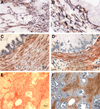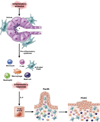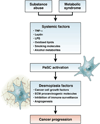A starring role for stellate cells in the pancreatic cancer microenvironment
- PMID: 23622130
- PMCID: PMC3729446
- DOI: 10.1053/j.gastro.2012.11.037
A starring role for stellate cells in the pancreatic cancer microenvironment
Abstract
Pancreatic ductal adenocarcinoma is a devastating disease, and patient outcomes have not improved in decades. Treatments that target tumor cells have largely failed. This could be because research has focused on cancer cells and the influence of the stroma on tumor progression has been largely ignored. The focus of pancreatic cancer research began to change with the identification of pancreatic stellate cells, which produce the pancreatic tumor stroma. There is compelling in vitro and in vivo evidence for the influence of pancreatic stellate cells on pancreatic cancer development; several recent preclinical studies have reported encouraging results with approaches designed to target pancreatic stellate cells and the stroma. We review the background and recent advances in these areas, along with important areas of future research that could improve therapy.
Copyright © 2013 AGA Institute. Published by Elsevier Inc. All rights reserved.
Conflict of interest statement
Conflicts of interest
The authors disclose no conflicts.
Figures





References
-
- Apte MV, Wilson JS. Dangerous liaisons: pancreatic stellate cells and pancreatic cancer cells. J Gastroenterol Hepatol. 2012;27(Suppl 2):69–74. - PubMed
-
- Apte MV, Park S, Phillips PA, et al. Desmoplastic reaction in pancreatic cancer: role of pancreatic stellate cells. Pancreas. 2004;29:179–187. - PubMed
-
- Marrache F, Pendyala S, Bhagat G, et al. Role of bone marrow-derived cells in experimental chronic pancreatitis. Gut. 2008;57:1113–1120. - PubMed
-
- Sparmann G, Kruse ML, Hofmeister-Mielke N, et al. Bone marrow-derived pancreatic stellate cells in rats. Cell Res. 2010;20:288–298. - PubMed
Publication types
MeSH terms
Grants and funding
LinkOut - more resources
Full Text Sources
Other Literature Sources
Medical

